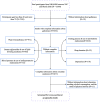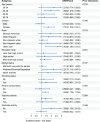Gender and activity disparities in the relationship between circadian syndrome and gallstone disease
- PMID: 39764254
- PMCID: PMC11701000
- DOI: 10.3389/fendo.2024.1439514
Gender and activity disparities in the relationship between circadian syndrome and gallstone disease
Abstract
Objective: To explore the potential correlation between gallstone disease (GSD) prevalence and circadian syndrome (CircS).
Methods: The cross-sectional research utilized data spanning 2017 to March 2020, sourced from the National Health and Nutrition Examination Survey (NHANES). The GSD data were collected via questionnaires, with appropriate sample weights applied to ensure the study population was representative. Three multivariable logistic regression models were built to clarify the connection between CircS and GSD. Furthermore, subgroup analysis and interaction test were carried out, categorized based on demographic traits and lifestyle aspects, to discern the potential influence of these variables on the correlation.
Results: The analysis included 4,126 participants, with a prevalence of 38.68% for CircS and 12.04% for GSD. The multivariable logistic regression analysis indicated a positive correlation between CircS and the prevalence of GSD (Odds Ratio (OR) = 1.336, 95% Confidence Interval (CI): 1.048, 1.702). When stratified by the number of CircS components, a positive correlation was observed between the number of CircS components and the prevalence of GSD (P for trend < 0.05). In particular, individuals with six or more CircS components had a higher prevalence of GSD than those with three or fewer components (OR = 2.608, 95% CI: 1.464, 4.647). The subgroup analysis and interaction test revealed that a positive correlation between CircS and GSD prevalence was mainly observed in female individuals (OR = 1.701, 95% CI: 1.236, 2.341) and individuals not engaged in moderate activity (OR = 1.990, 95% CI: 1.158, 3.418).
Conclusion: There is a positive correlation between CircS and GSD prevalence, particularly among females and individuals not engaging in moderate activity. These findings offer new insights for research directions in GSD and may impact preventive and therapeutic strategies.
Keywords: National Health and Nutrition Examination Survey (NHANES); circadian syndrome; cross-sectional study; gallstone disease; metabolic syndrome.
Copyright © 2024 Feng, Wang, Han, Yang, Wang and Li.
Conflict of interest statement
The authors declare that the research was conducted in the absence of any commercial or financial relationships that could be construed as a potential conflict of interest.
Figures



Similar articles
-
The Association between Circadian Syndrome and Frailty in US adults: a cross-sectional study of NHANES Data from 2007 to 2018.Aging Clin Exp Res. 2024 May 7;36(1):105. doi: 10.1007/s40520-024-02745-3. Aging Clin Exp Res. 2024. PMID: 38713270 Free PMC article.
-
The relationship between oxidative balance score and circadian syndrome: evidence from the NHANES 2005-2018.Front Endocrinol (Lausanne). 2024 Oct 11;15:1431223. doi: 10.3389/fendo.2024.1431223. eCollection 2024. Front Endocrinol (Lausanne). 2024. PMID: 39464189 Free PMC article.
-
Association between circadian syndrome and MASLD risk: evidence from a large cross-sectional study.BMC Gastroenterol. 2025 May 21;25(1):391. doi: 10.1186/s12876-025-03997-7. BMC Gastroenterol. 2025. PMID: 40399801 Free PMC article.
-
Complex impacts of gallstone disease on metabolic syndrome and nonalcoholic fatty liver disease.Front Endocrinol (Lausanne). 2022 Nov 23;13:1032557. doi: 10.3389/fendo.2022.1032557. eCollection 2022. Front Endocrinol (Lausanne). 2022. PMID: 36506064 Free PMC article.
-
[Frequency combination of a gallstone disease and diabetes].Eksp Klin Gastroenterol. 2011;(4):99-102. Eksp Klin Gastroenterol. 2011. PMID: 21916209 Review. Russian.
Cited by
-
Serum lipids, oxidative stress, and systemic inflammation mediate the association between circadian syndrome and periodontitis.Front Nutr. 2025 Jul 2;12:1622348. doi: 10.3389/fnut.2025.1622348. eCollection 2025. Front Nutr. 2025. PMID: 40672423 Free PMC article.
References
MeSH terms
LinkOut - more resources
Full Text Sources

